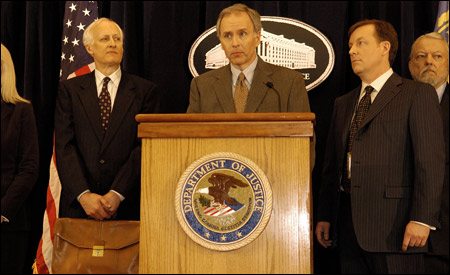
DITHERING LIKE THE DEMOCRATS?: Or is this a truly subversive film in the making . . . |
When the title and the premise alone piss off Hillary Clinton and Rush Limbaugh, why cop out when making the film itself? People like that aren’t even going to watch it; they just welcome the opportunity to vent their outrage and get attention. Meanwhile, Gabriel Range’s mock-documentary account of an imagined assassination of President Bush and its consequences might not get so much attention once people start seeing it. The idea provokes, the computer tinkering of archival images startles, but the overall impact, argument, and narrative are as dithering as the past six years of Democratic opposition.
In fact, outside of an RNC Web site, it would be hard to find a more laudatory portrait of the current chief executive. The film begins with talking heads describing the events that led up to the tragedy. The head of the Secret Service unit assigned to protect the president, a smarmily sentimental adviser and speechwriter, and even some journalists testify, sometimes teary-eyed, as to what a great guy Bush was, as they recall what happened.

It seems that in October of 2007 the world is not much different from the way it is now, with Iraq a shambles, North Korea making noise, and Dennis Hastert still Speaker of the House. The only difference — and this is one of Range’s more far-fetched imaginings — is that the anti-war movement has swollen to 1960s intensity. These radicals, Range suggests, are the real bad guys; their violent demonstrations as Bush arrives in Chicago for a speech “legitimize” and set the scene for the terrible act to follow. Range more or less accuses them of collusion.
In “archival” footage reminiscent of Dallas 1963, Air Force One lands and the presidential motorcade proceeds in images that, along with the William Manchester–derived title, emphasize a link with Camelot’s martyr. But rather than dispelling speculations about a conspiracy and pinning the blame on a lone gunmen, as the Warren Commission did, the FBI here must disprove that a single individual was responsible and dredge up “proof” of a conspiracy (al-Qaeda!) in order to justify increasingly repressive security measures.
A bolder filmmaker might have jumped all over this line of development, postulating what kind of Land of the Free would emerge after Cheney and company, enthroned by such an outrage, helped themselves to power without restraints. Just look how they exploited 9/11. But aside from a few dropped hints about fitting the evidence to preconceived conclusions (James Urbaniak as a dissident FBI forensics expert offers some acid bite), Range lets such notions drift and evaporate like the musings of a lunatic.
Unless I’m missing the point. After all, the film itself has to have been made post-assassination, after the imposition of “Patriot III” (the details of which are left unstated), an act that would, one assumes, have restricted investigations into the truth. In which case Death might be even more subversive than its ignorant critics have claimed it to be.
On the Web
Death of a President: //www.deathofapresident.com/